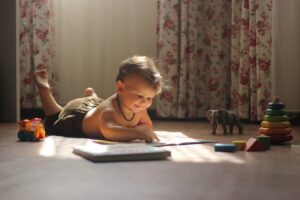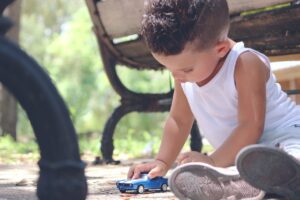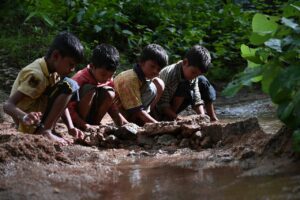
But what exactly do we mean by play?
Let’s begin to narrow the field by looking at what this kind of play is not:
Not driven by the commercial culture; not based on a movie, not “themed”, not initiated in order to sell merchandise, not packaged, not bought or sold.
Not technological, does not require a device of any sort, not a screen “interacting” with the child, not “learn through play” technology.
Not sports ( in early childhood, as we discussed earlier )
Not adult-initiated, adult regulated, or adult directed.

What, then, is play? Asking this question is in the same category as asking “What is love?” or “Can we know there is God?” Scientific research will probe play for a very long time, and still not produce an adequate definition.
The following, though, is a description/definition I wrote a number of years ago; perhaps it is a place to begin:
“Play is an amalgamation of alchemy and science, giving the child not only a magic wand, but also a powerful tool of experimentation. Here, in play, the child mixes a potent brew of her daily experiences as well as her wishes and dreams. Daily experiences are played- through not only in order to understand them, but also to change and transform them. This thereby changes and transforms the child. Any timid child who, in imaginative play, has built a little fort behind the couch, covered it with dark blankets and faced the terrors of the night, emerges from this game as someone new. A little ruffian who is set upon the task by a playmate to “Look after the baby until I am back from the store” has a softer look in the eye upon his friend’s return.
Children also use creative play as a way to unravel life’s challenging experiences. A new
baby in the family, a move across the country, the death of a grand parent become themes the child can work through again and again: What is this feeling I have? How can I express it? How do I make sense of it? How can I regain balance?”

Let’s look at the principles that underlie this open-ended kind of play, which we can call playing from the inside out :
This play is fluid. If there are rules, the child or children have created them and they evolve along with the flow of the game. This provides the opportunity for learning negotiation skills as well as coping skills and adaptability when negotiations do not produce the preferred results.
It is driven by the play partners’ internal self: images, questions, curiosities, struggles, life occurrences. It is open ended, not scripted by the influence of media- driven story plots.
Although an adult is necessary ~ somewhere close-enough ~ to help with self-
regulation and facilitate through rough spots, she is central to the play only in her loving connection. She has not initiated it, nor directs it; she influences it in subtle ways but does not take the lead.


We can summarize these principles with this quote from the Playworkers in the UK: “Play
is a process that is freely chosen, personally directed and intrinsically motivated. That is,
children and young people determine and control the content and intent of their play, by
following their own instincts, ideas and interests, in their own way for their own reasons.”
To delve more deeply into Creative Play, follow this link to an article by Peter Gray, from his
Substack Play Makes us Human. It is titled “The Cruelty of US Kindergartens.”
This article is excerpted from With Stars in Their Eyes: Brain Science and Your Child’s Journey Toward the Self, by Sharifa Oppenheimer.
